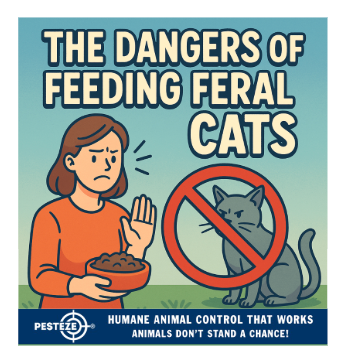THE DANGERS OF FEEDING FERAL CATS

THE DANGERS OF FEEDING FERAL CATS
SUMMARY
Feeding feral cats might feel compassionate, but it can create serious health, environmental, and community issues. This guide explains why feeding feral cats is risky, the consequences it can have, and humane alternatives for helping these animals.
FEATURES
-
Overpopulation risks: Feeding colonies encourages rapid breeding.
-
Spread of disease: Feral cats can transmit parasites and illnesses to pets and humans.
-
Wildlife impact: Cats hunt birds and small mammals, disrupting ecosystems.
-
Nuisance problems: Feeding sites attract noise, odors, and property damage.
-
Health risks for cats: Feeding without veterinary care does not improve cat welfare.
-
Better alternatives: Trap-Neuter-Return (TNR) and shelters offer long-term solutions.
GUIDE DESCRIPTION
Feral cats are common in urban and suburban areas, often living in groups known as colonies. While feeding these cats may seem like a kind-hearted gesture, it can actually make problems worse for both the cats and the community. Understanding the dangers of feeding feral cats is the first step toward finding better, humane solutions.
One of the greatest risks is overpopulation. Cats are prolific breeders, and a well-fed colony can expand quickly. A single female cat can produce multiple litters each year, leading to exponential growth when food sources are consistent. This makes the feral cat crisis harder to control.
Another concern is the spread of disease. Feral cats often carry parasites like fleas, ticks, and worms, as well as dangerous illnesses such as rabies, toxoplasmosis, and feline leukemia virus. Feeding stations can become hotspots for disease transmission, endangering not only other cats but also household pets and even humans.
Feeding feral cats also has a negative impact on wildlife. Well-fed or not, cats retain strong hunting instincts and often kill birds, small mammals, reptiles, and amphibians. Studies show that feral and outdoor cats are responsible for billions of wildlife deaths annually, disrupting delicate ecosystems.
In addition, colonies fed by humans can become nuisance problems. Concentrations of cats lead to loud fights, foul odors from spraying and feces, and property damage such as digging or sheltering under porches. Neighbors may feel frustrated or unsafe, which can cause conflicts within communities.
It’s also important to note that feeding alone does not improve cat welfare. Many feral cats live with untreated injuries, infections, and malnutrition despite regular feeding. Without veterinary care, the root problems persist, leaving the cats vulnerable.
The best approach is seeking better alternatives such as Trap-Neuter-Return (TNR) programs. TNR involves humanely trapping feral cats, spaying or neutering them, vaccinating them, and then returning them to their colony. This stabilizes populations and improves overall health. In some cases, adoptable kittens and friendly strays can be placed into shelters or foster homes.
By avoiding casual feeding and instead supporting structured TNR and rescue efforts, communities can reduce feral cat populations, protect wildlife, and provide cats with better long-term outcomes.
- Saneeth Thota


Comments 0